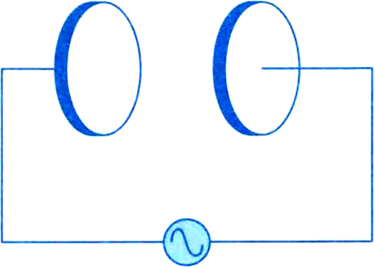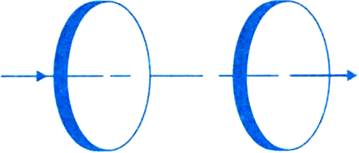In a plane electromagnetic wave, the electric field oscillates sinusoidally at a frequency of 2.0 × 1010 Hz and amplitude 48 V m-1.
(a) What is the wavelength of the wave?
(b) What is the amplitude of the oscillating magnetic field?
(c) Show that the average energy density of the E field equals the average energy density of the B field, [c = 3 × 108 m s-1]
Here,
Therefore,
Wavelength of the wave,
Amplitude of oscillating magnetic field,
Energy density in electric field,
Energy density in magnetic field,
Using the relation, we have
But,
Hence, the average energy density of electric field equals the average energy density of magnetic field.
A parallel plate capacitor (Fig.) made of circular plates each of radius R = 6.0 cm has a capacitance C = 100 pF. The capacitor is connected to a 230 V ac supply with a (angular) frequency of 300 rad s-1.
(a) What is the rms value of the conduction current?
(b) Is the conduction current equal to the displacement current?
(c) Determine the amplitude of B at a point 3.0 cm from the axis between the plates.
Given, a parallel plate capacitor made of circular plates.
(a) Here,
Radius of the circular plate, R = 6.0 cm
Therefore,
(b) Yes, the conduction current is equal to the displacement current.
(c) We know that,
This formula goes through even if displacement current, ID (and therefore magnetic field B) oscillates in time. The formula above shows that they oscillate in phase.
Since ID = I, we have
If I = I0, the maximum value of current, then
Amplitude of B = maximum value of B
(a) (i) ![]()
or ![]()
![]()
(ii) ![]()
(iii) ![]()
![]()
(iv) ![]()
(b) Let the electromagnetic wave travel along +x-axis, and ![]() are along y-axis and z-axis respectivelty. Then,
are along y-axis and z-axis respectivelty. Then,![]()
![]()
![]()

(a) Given,
Radius of capacitor plates, r = 12 cm = 0.12 m
distance between the plates, d = 5.0 mm = 5 × 10-3m
Charge carried, I = 0.15 A
Permittivity of medium, 0 = 8.85 × 10-12 C2 N-1 m2
∴ Area of cross-section of plates, A = R2 = 3.14 × (0.12)2 m2
Capacitance of parallel plate capacitor is given by
Now, charge on capacitor plate,
(b) Displacement current is equal to the conduction current i.e., 0.15 A.
(c) Yes, Kirchhoff's first rule is valid at each plate of the capacitor provided. We take the current to be the sum of the conduction and displacement currents.
